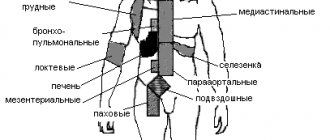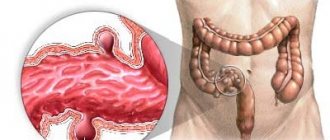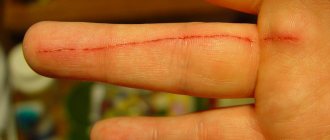Thyroid diseases are a common problem: they rank second among all endocrine system disorders. The reason for this is the deterioration of the environmental situation, regular stress and iodine deficiency, which are typical for residents of large cities. One of these diseases is diffuse nodular goiter, which combines 2 different pathological processes: the formation of nodular formations and enlargement of thyroid tissue. The Alpha Health Center clinic is a modern medical center where you can make an appointment any day. You will receive professional advice from an endocrinologist with more than 7 years of experience and a personally developed treatment regimen.
What is a goiter
In medicine, this term refers to a pathological change in the thyroid gland, expressed in the formation of nodules. A node, in turn, is a neoplasm of any size with a capsule, determined by palpation or during a visual examination. The diffuse type of the disease involves uniform tissue proliferation. And mixed cases in which both of these pathological processes are combined are called diffuse nodular goiter.
With this disease there is no connection with tumor, or neoplastic, or inflammatory processes. Enlargement of the thyroid gland with diffuse nodular goiter is not an oncological pathology. This is a consequence of other, independent pathological conditions or changes.
Diffuse nodular goiter is more often diagnosed in women than in men. According to medical statistics, among patients with this disease there are 3 times more females. The vast majority of them are of middle age.
General information
Endocrinologists call benign lesions of the thyroid gland of various nosological forms goiter. Symptoms of the pathology are diagnosed in 40% of the population. Girls encounter the disease 2-4 times more often. During the examination, doctors are able to detect nodes with a diameter of more than 10 millimeters; up to 50% of small nodes are detected only by ultrasound. The multinodular type of pathology is formed in patients who have more than two confirmed formations in the thyroid gland.
Causes
The reasons why diffuse nodular goiter develops are not exactly clear. The most likely predisposing factors are considered to be age-related changes in the body associated with changes in the endocrine system and an unbalanced diet. The risk of developing diffuse nodular goiter increases with frequent and chronic stress, reduced immunity, and unfavorable environmental conditions.
The disease often develops against the background of:
- psychological injuries;
- infectious processes in the body;
- inflammatory diseases;
- autoimmune disorders;
- genetic predisposition;
- insufficient consumption of iodine-containing products;
- diseases of the central nervous system;
- bad habits;
- brain injuries;
- hormonal disorders.
Medical practice also shows that signs of a nodular process in the tissues of the thyroid gland are often found in elderly patients. This suggests that the development of diffuse nodular goiter may be associated with the natural mechanism of aging.
Etiology of the disease
The causes of goiter growth are varied. Endocrinologists suggest that changes in the thyroid gland are formed due to mutations in the genes responsible for the production of hormones. Some mutations are inherited by children from their parents.
Doctors consider risk factors to be:
- genetic disorders;
- exposure to toxins and radiation;
- deficiency of microelements in the body;
- taking certain groups of medications;
- use of tobacco products;
- stressful situations.
Viral and bacterial diseases with a chronic course have a significant impact on the likelihood of developing goiter.
Symptoms
Diagnosis of diffuse nodular goiter can be complicated by the fact that the disease manifests itself in different ways. In most cases, changes in the body are accompanied or are a consequence of increased synthesis of thyroid hormones. But this condition is not always met in diffuse nodular goiter. In some cases, thyroid hormones, on the contrary, decrease or are within normal limits.
At an early stage, the course of the disease often has a latent form. Even with careful diagnosis, it is not always possible to recognize it. As diffuse nodular goiter increases, the symptoms of the disease become more vivid and noticeable.
Patients complain:
- to an unreasonably hoarse voice;
- labored breathing;
- causeless dry cough;
- hypertrophy of the thyroid gland, that is, its visual enlargement, noticeable externally.
Diffuse nodular goiter of the 1st degree can manifest itself as severe pain in the larynx, not associated with colds or infectious diseases. The patient feels constant discomfort when swallowing food or drinks, and when he tries to tilt his head, he experiences unpleasant compression. Dizziness is often observed with diffuse nodular goiter.
Subsequently, the symptoms worsen. Manifestations of diffuse nodular goiter of the 2nd degree are increasingly reminiscent of the symptoms of thyrotoxicosis, which occurs when the production of thyroid hormones increases. Characteristic signs of the disease at this stage are pain in the chest and behind the sternum, arterial hypotension, shortness of breath, which bothers you even after light physical exertion.
Diffuse nodular goiter of the 2nd degree can manifest itself:
- insomnia;
- decreased or lack of appetite;
- pain in the neck and larynx;
- irritability;
- nervousness.
Complaints about dermatological problems are possible - for example, patients with diffuse nodular goiter are often bothered by dryness and flaking of the skin. Elderly patients are characterized by impaired cognitive functions, in particular, forgetfulness and memory impairment. A decrease in body temperature may be observed with diffuse nodular goiter. In men, there are frequent cases of weakened erectile function and problems with potency, in women - menstrual irregularities, infertility, and during pregnancy - miscarriage.
Diffuse nodular goiter is a disease that can affect not only an adult, but also a child at an early age. The danger of pathological tissue proliferation in combination with nodular neoplasms of the thyroid gland is that it can negatively affect the mental and physical development of a young body. At the same time, the process of eliminating pathology, taking into account its anatomical location, is very complex. Often, with diffuse nodular goiter, Graves' syndrome develops due to excess thyroid hormone. It has a toxic effect on the body, which is manifested by nervousness, anxiety, and a constant feeling of hunger. This disease is also characterized by dry skin, tremor (uncontrollable shaking) of the lower and upper extremities, and protruding eyes.
With large diffuse nodular goiter, the symptoms also have their own specifics. A formation in the thyroid gland leads to compression of nearby tissues and structures, making swallowing and head movements difficult. The disease can lead to aphonia - loss of voice, paralysis of the recurrent laryngeal nerve. An enlarged thyroid gland is accompanied by dyssomnia, sweating, and sudden and causeless weight loss. If pain occurs, this indicates that the diffuse nodular goiter is pressing on the esophagus and trachea. Paralysis of the vocal cords and tissue fusion are observed with malignancy of the pathological process.
Combination therapy
Thyreostatic drugs are administered only to achieve euthyroidism, and then they are used together with thyroxine, for example, 20 mg of methizol + 50 mcg of thyroxine. The purpose of administering thyroxine is to prevent the onset of hypothyroidism and to prevent the goiter from enlarging due to unblocking of TSH.
Be aware of the beneficial effects of beta blockers, B vitamins, and possibly sedatives.
Beta blockers - the main effect of drugs in this group is to block beta receptors, which reduces the activity of the adrenergic system. Let us recall that with hyperthyroidism there is an increase in the sensitivity of beta receptors to catecholamines and an increase in their density.
Combination therapy
These drugs also reduce the conversion of peripheral T4 to T3.
The most commonly used:
- propranolol at a dose of 80-160 mg/day;
- Metocard at a dose of 100-200 mg/day;
- Atenolol at a dose of 50-200 mg/day.
In case of contraindications to the use of drugs from this group, calcium channel blockers, for example, Isoptin, can be prescribed as an alternative.
Additional notes:
- During the initial period of treatment, physical activity should be avoided (valid medical certificate);
- the course of treatment may be aggravated by stress factors;
- preventive vaccinations are contraindicated;
- the patient should be instructed about the possibility of granulocytopenia and associated symptoms, as well as the need to consult an endocrinologist if they occur;
- granulocytopenia can also be a symptom of Graves' disease itself, so its detection before treatment is not a contraindication to the use of thyreostatic drugs;
- If Graves' disease has been cured, iodine should not be given as this medicine may cause the disease to recur.
In cases of drug intolerance, relapse of hyperactivity after treatment or very strong patient resistance, we turn to radical treatment, that is, 131 I treatment, or nowadays, less commonly, to surgical treatment.
Stages and types of disease
The World Health Organization divides the development of diffuse nodular goiter into several forms:
- zero;
- primary;
- secondary.
They are determined by the severity of symptoms. With the zero form of diffuse nodular goiter, there are no clinical manifestations. The primary form of the disease can be diagnosed after palpation. Secondary diffuse nodular goiter is when the tumor is visually noticeable.
Classification is also used according to the type of nodular formations. From this point of view, cystic formations and pseudonodules are distinguished. Their number also varies - from single or solitary formations to multinodular, conglomerate ones.
How can I come to you for a consultation and biopsy?
To make an appointment for a biopsy and consultation with an endocrinologist surgeon or endocrinologist at the North-Western Endocrinology Center, you need to call the Petrograd or Primorsky branches of the Endocrinology Center:
- (812) 498-10-30, from 7.30 to 20.00, seven days a week
,
St. Petersburg, Kronverksky pr., 31
(200 meters on foot to the left from the Gorkovskaya station, in the very center of the city, 500 meters from the Peter and Paul Fortress ). For those arriving by car, there is parking right in front of the entrance to the Center. - (812)565-11-12
, from 7.00 to 21.00 weekdays, from 7.00 to 19.00 - weekends, St. Petersburg, Savushkina street, 124, building 1 (250 meters to the right from the Begovaya metro station). There is adjacent car parking in front of the Center entrance.
Diagnostics
To diagnose diffuse nodular goiter, an initial examination by an endocrinologist is necessary. It allows you to identify signs of the disease through visual assessment and palpation. If there is a suspicion of diffuse nodular goiter, the doctor will prescribe additional tests to clarify the diagnosis:
- blood test - to check the concentration of thyroid hormones;
- stool and urine analysis;
- Ultrasound examination allows you to find out the cause of the nodular formation.
To exclude the possibility of developing cancer, a fine-needle aspiration biopsy is used. It is performed if the diameter of the nodular formation reaches a centimeter or more. Scintigraphy is also performed - radioisotope scanning, which makes it possible to study the autonomy of the functional thyroid gland. Computed tomography provides the doctor with information about the size of the organ, its contours and structure, and the features of regional lymph nodes. X-rays are needed to ensure that foreign objects do not enter the esophagus or sternum area.
Only after laboratory tests are carried out, the endocrinologist selects drug therapy for the patient, which can gradually reduce the manifestations of the disease.
Chronic autoimmune thyroiditis
Chronic autoimmune thyroiditis
- chronic disease of the thyroid gland of an autoimmune nature. In which, as a result of a long-term process, gradual destruction of thyroid tissue occurs, most often leading to the development of hypothyroidism (underfunction of the thyroid gland). This disease develops more often in women after 40 years of age. The disease is caused by a genetic predisposition and is realized under the influence of environmental factors, including iodine deficiency.
Classification
- Hypertrophic autoimmune thyroiditis - characterized by an increase in the volume of the thyroid gland against the background of massive autoimmune infiltration with the formation of a goiter, often with nodes;
- Atrophic autoimmune thyroiditis is characterized by a decrease in thyroid volume with the formation of connective tissue instead of functioning thyroid tissue.
Clinical picture
The phase of the disease with normal thyroid function (the so-called euthyroid phase of the disease) can last for years. Further, as the pathological process of destruction of the follicular epithelium (working tissue of the thyroid gland) progresses, the number of cells producing thyroid hormones decreases and the clinic of hypothyroidism develops (insufficiency of thyroid function, which is characterized by the appearance of complaints of severe fatigue, drowsiness, dry skin, hair loss, slow speech, swelling of the face, constipation, memory loss). Rarely, autoimmune thyroiditis can begin with thyrotoxicosis. The reason for this may be massive destruction of thyroid cells with the subsequent release of the hormone accumulated there into the circulating blood. A feature of the course of the thyrotoxic phase of autoimmune thyroiditis in most cases is the absence of a pronounced clinical picture, and it proceeds as subclinical thyrotoxicosis (erased clinical picture, reduced TSH with normal T3 and T4 values).
As can be seen from the above, the clinical picture of autoimmune thyroiditis is often erased; most often the diagnosis is made on the basis of instrumental and laboratory data.
Diagnosis criteria
- Increased level of circulating antibodies to the thyroid gland (antibodies to thyropyroxidase (more informative) and antibodies to thyroglobulin);
- Detection of typical ultrasound data of autoimmune thyroiditis (diffuse decrease in the echogenicity of the thyroid tissue and an increase in its volume in the hypertrophic form, in the atrophic form - a decrease in the volume of the thyroid gland.);
- Primary hypothyroidism (manifest or subclinical).
Of particular note
: In women planning a pregnancy, if antibodies to thyroid tissue are detected with ultrasound signs of AIT, it is necessary to examine the function of the thyroid gland (determining the level of TSH and T4 in the blood serum) before conception, as well as in each trimester of pregnancy.
Treatment
If diffuse nodular nontoxic goiter syndrome occurs without complications, the patient is prescribed hormonal therapy and radioactive iodine preparations. In some cases, surgical treatment is advisable. It is indicated for the development of neoplasia, pronounced external manifestations of goiter, difficulty swallowing and breathing associated with compression syndrome.
Therapy is aimed primarily at restoring the hormone-producing function of the thyroid gland. Treatment with radioactive iodine preparations for diffuse nodular goiter usually demonstrates good results. Radical removal of the organ through surgery and subsequent hormone replacement therapy are indicated only in the absence of results from the prescribed drug treatment.
The likelihood of malignancy of the process with diffuse nodular goiter is low. The prognosis is generally favorable. If changes in the structure of the thyroid gland were noticed at the early stage of diffuse nodular goiter and are not severe, the main role is given to conservative treatment. The doctor selects medications with iodine compounds that are actively absorbed by the human body. In most cases, this measure is sufficient to eliminate the negative symptoms of diffuse nodular goiter and gradually reduce the thyroid gland down to its normal size.
Complications
Without timely and adequate treatment, diffuse nodular goiter can lead to serious consequences. Therefore, doctors recommend seeking professional help immediately if you discover 3 or more signs of the disease. An advanced stage of diffuse nodular goiter increases the risk of malignancy of the process and the development of thyroid cancer. It often leads to death.
Other complications are possible with diffuse nodular goiter. Choking, problems with swallowing, compression of nerve endings and metabolic disorders can negatively affect the condition of many internal organs and systems.
Read also
Metabolic syndrome
Metabolic syndrome is a “pandemic of the 21st century.”
The prevalence of metabolic syndrome is 20–40%. In the Russian Federation, 40% of the population have 2 components of metabolic syndrome, 11% –… Read more
Complications of diabetes
Diabetes mellitus (DM) is a systemic disease caused by absolute (type 1) insulin deficiency or insulin resistance (type 2), which causes impaired carbohydrate metabolism, manifested by chronic...
More details
Osteoporosis
Osteoporosis is a progressive metabolic disease of the skeletal bones, which results in a decrease in bone density and disruption of its internal structure. The result of osteoporosis is...
More details
Diabetes mellitus, type 2
Diabetes mellitus (DM) is a group of metabolic diseases characterized by chronic hyperglycemia, which results from impaired insulin secretion, insulin action, or both...
More details
Thyrotoxicosis (hyperthyroidism)
Physiology of the thyroid gland: The function of the gland is to synthesize and secrete thyroid hormones. An increase in their number leads to more intense metabolism and vice versa. Thyroid function is regulated...
More details
Prevention
Since the exact reasons why diffuse nodular goiter of the thyroid gland develops are not yet clear, preventive measures are precautionary in nature.
Endocrinologists strongly recommend enriching your diet with foods rich in iodine:
- sea fish;
- crustaceans;
- seaweed;
- whole milk;
- beef.
Adequate nutrition is especially important when the immune system is weakened, in childhood and old age. If one of your close relatives has been diagnosed with diffuse nodular goiter, it is recommended to regularly visit an endocrinologist and monitor hormone levels through testing - at least once a year. Good sleep, a properly organized rest regimen, and an active lifestyle will also help reduce the risk of developing the disease.
Questions and answers
What preventive measures can prevent the development of goiter?
Patients at risk should visit an endocrinologist. During the consultation, the doctor will talk about the features of the diet, permissible physical activity and rest regime. Self-administration of iodine-containing drugs is unacceptable. The likelihood of developing a goiter will decrease if you quit smoking and systematically drink alcohol.
Is nodular goiter an inherited disease?
Children of parents suffering from goiter are at risk. Such babies require regular examinations by an endocrinologist for early detection of signs of pathology.
Diagnosis and treatment of diffuse nodular goiter of the thyroid gland in Moscow
The danger of diffuse nodular goiter is that in the early stages it practically does not manifest itself externally. Symptoms become apparent only after changes in thyroid hormone levels and significant enlargement of the thyroid gland. The later diffuse nodular goiter is diagnosed, the more radical methods of therapy may be needed.
"Alpha Health Center" recommends checking the condition of the thyroid gland, and if necessary, undergoing treatment in a modern medical center.
For more information or to make an appointment, please contact the front desk. Share:
Why are we so categorical, so radical?
Let us answer the first part of your question - the diagnosis of follicular adenoma of the thyroid gland cannot be made based on the results of a fine-needle biopsy simply because it is IMPOSSIBLE
. No one in the world can reliably establish a diagnosis of follicular adenoma - this issue is now the main scientific direction in the diagnosis of thyroid nodules.
Let's clarify our position using some simple theoretical concepts.
When we, endocrinologists and endocrine surgeons, identify a nodule in the thyroid gland in a patient, we first must decide on the basic question: “Is this nodule benign or malignant?” To put it even simpler and more specifically: “Is it cancer or not?”
The main method to answer this simple and at the same time extremely important question for the patient is a fine-needle biopsy of thyroid nodules.
. It is precisely this that is designed to separate nodes into those that are dangerous to humans and those that are not. Many patients will be surprised, but the main purpose of a biopsy is not to prescribe surgery for patients to remove nodes, but to save patients from surgery. A biopsy allows you to tell the patient without any surgery that he has a benign node (and 95% of nodes are benign), and then, based on the conclusion of the biopsy, give advice not to remove the node and not to perform any operations. In those days when biopsies did not exist, doctors recommended removing all identified nodes - otherwise they could not guarantee the patient that he would not “miss” cancer. And now in many regions of our country (primarily where biopsies are not done or done poorly) doctors recommend removing almost all nodes. But doctors often cannot understand that by the age of 50, 50% of women have nodes in the thyroid gland, and if we move forward by removing them, then by a certain age we will remove the thyroid gland at least half of the women in our country...
A thyroid biopsy allows you to divide the nodes into those that need to be removed (fortunately, there are few of them - about 7-8%), and those that should not be removed - there are much more of them, about 92-93%.
How does a biopsy do this?
The first thing a biopsy can do is divide the nodes into tumor and non-tumor. Many people do not know, but all nodules in the thyroid gland are divided, first of all, into tumors and non-tumors.
Non-tumors, of which the vast majority are, are so-called colloidal nodes, absolutely benign round formations that look like a tumor, but from the point of view of their microscopic structure they are not a tumor. The only problem with these nodes is the fact that they are very, very similar when performing an ultrasound or palpating the thyroid gland for a tumor - that is why they are removed so often. A high-quality biopsy allows us to say with confidence that the nodule is colloidal - which means it is not cancer and will NEVER “degenerate” into it. Benign colloid nodes do not turn into cancer - this fact has been proven by science for quite a long time. And colloid nodules make up about 92-95% of all thyroid nodules - much to the happiness of all mankind.
Tumor nodules of the thyroid gland differ from colloidal non-tumor nodules in that in tumors there is always one “mother” cell in which a DNA mutation has occurred that causes uncontrolled division. Reproduction of the mother cell leads to the formation of a node in the thyroid gland, all the cells of which are in one generation or another descendants of the mother cell (there is no such phenomenon in the colloid node - all the cells divide there at once, which is why it is non-tumor).
Tumor nodes in the thyroid gland can be benign or malignant. A benign tumor node is otherwise called a thyroid adenoma, and a malignant one is called thyroid cancer.
.
The second task that fine-needle biopsy is designed to solve is the division of tumor nodes into malignant and benign. And biopsy cannot yet cope with this task 100%.
A biopsy can detect a number of malignant tumors immediately - for example, papillary cancer, medullary cancer, squamous cell carcinoma, anaplastic cancer, thyroid lymphoma, metastases of other tumors to the thyroid gland.
However, there are two types of tumors that are indistinguishable from each other based on the results of a fine-needle biopsy. We are talking about follicular adenoma of the thyroid gland
(a benign tumor originating from follicle cells that produce hormones) and
follicular carcinoma of the thyroid gland
(or follicular cancer - a malignant tumor of the thyroid gland that grows from the same hormone-producing follicle cells).
Why can't a biopsy distinguish an adenoma from a carcinoma? The fact is that the cells that form these two tumors are the same
- These are ordinary cells of the thyroid follicles. When analyzing a smear obtained after a fine-needle biopsy of the thyroid gland, clusters of follicular cells are visible that are actively dividing - and that’s all that can be said from the results of the biopsy. It can be seen that the node has a follicular structure, that it consists of follicular cells, and these cells divide - which means we are talking about a tumor. Nothing more to say.
The main difference between follicular cancer and follicular adenoma of the thyroid gland is the presence of capsule invasion in the cancerous nodes
.
The fact is that both tumors - carcinoma (cancer) and adenoma (benign tumor) - are covered with a capsule that surrounds the node, like a thin membrane. Adenoma cells are not able to rupture the membrane and penetrate into the surrounding tissue, but cancer cells (carcinoma) do this quite easily. That is why the presence of foci of rupture of the capsule of the node with germination (invasion) of tumor cells into the surrounding tissue is the main sign of follicular thyroid cancer. This is an unshakable, undisputed fact. There is invasion - this is cancer, no invasion - this is follicular adenoma
.
Now let's think about how we can detect invasion of the node capsule by a tumor during a fine-needle biopsy? After all, a biopsy is carried out with a very thin needle by injecting into the tissue of the node, followed by sucking the contents of the node into a syringe, and then blowing this content onto the glass, and then smearing this content on the glass to prepare a thin smear. The thinner the smear, the better the individual cells are visible, the better the quality of the biopsy taken and the higher the likelihood of an informative answer. But the capsule of the node cannot be sucked out during a biopsy - this is obvious. And it is also impossible to find out how the cells were located in the node before the biopsy - after all, they are mixed in the needle, and in the syringe, and on the glass when the cellular material is smeared. Therefore, it is impossible to say whether the invasion of the node capsule by a tumor was based on the results of a fine-needle biopsy - for this it is necessary to study the entire capsule, the entire node
. This is as impossible as trying to find out whether, say, there were dark spots on the skin of an orange by drinking the orange juice obtained from it through a straw - to say something about the skin of an orange, you need to study the skin, not the juice.
The only way to tell whether the tumor has invaded the capsule of the node (and therefore to decide whether the node under study is a follicular adenoma of the thyroid gland or follicular cancer
) is to remove the entire node and carefully examine its entire capsule under a microscope in search of foci of invasion, “holes” in the capsule. This is logical and obvious.
From the above reasoning it follows that, according to fine-needle biopsy data, it is IMPOSSIBLE to establish the diagnoses of “Follicular adenoma of the thyroid gland” and “Follicular cancer of the thyroid gland”.
. It’s impossible not because the doctor’s knowledge or equipment is lacking, but it’s purely technically impossible. Therefore, such diagnoses cannot be formulated based on the results of a biopsy. And therefore, in the modern worldwide classification of the Bethesda system, released in 2010, it is indicated that the conclusion must be formulated as follows: “Follicular tumor of the thyroid gland.” Those. The cytologist understands that this is a tumor of follicular cells, he also understands that in this case he cannot distinguish cancer from adenoma due to the limitations of the method, so he simply writes a general conclusion “Follicular tumor”. If the node is removed (and this is now customary to do with all follicular tumors) and the doctor has the opportunity to evaluate the entire node with its capsule, the diagnosis will be definitively established - either cancer or not cancer (adenoma).
Two important conclusions emerge from this lengthy discussion.
First, the diagnosis of “Follicular adenoma of the thyroid gland” can only be established after complete removal of the node
.
Secondly, if a cytologist does not understand this and writes a conclusion “Follicular adenoma of the thyroid gland” based on the results of a fine-needle biopsy, it means that he does not understand the very logic of this diagnostic method, is not oriented in modern classifications and rules for establishing a diagnosis, and therefore his conclusions cannot be trusted
.
This is precisely why we told you at the beginning of the article that the diagnosis of follicular adenoma of the thyroid gland based on the results of a fine-needle biopsy of the node is an INCORRECT diagnosis, and there are no exceptions to this rule.






